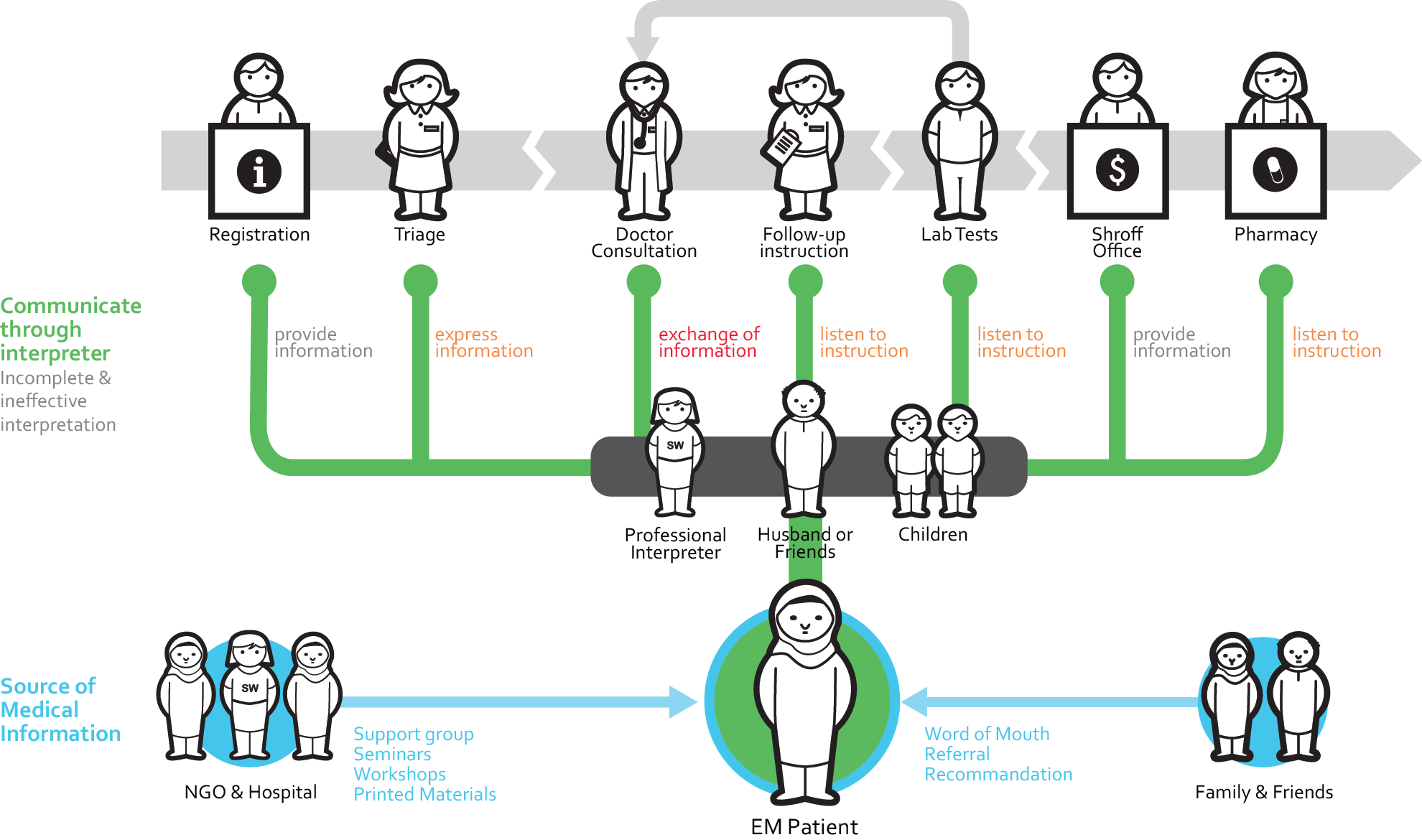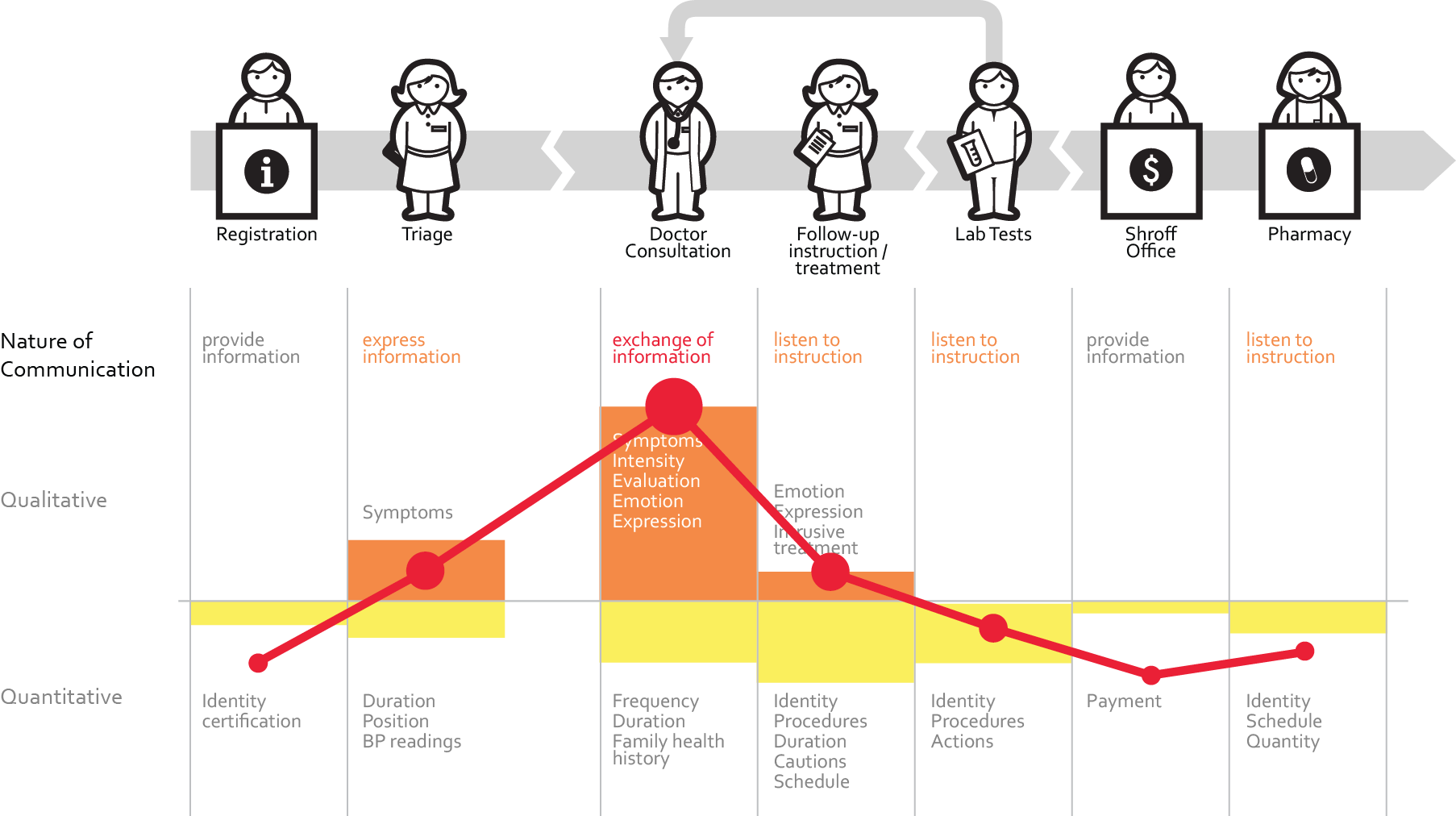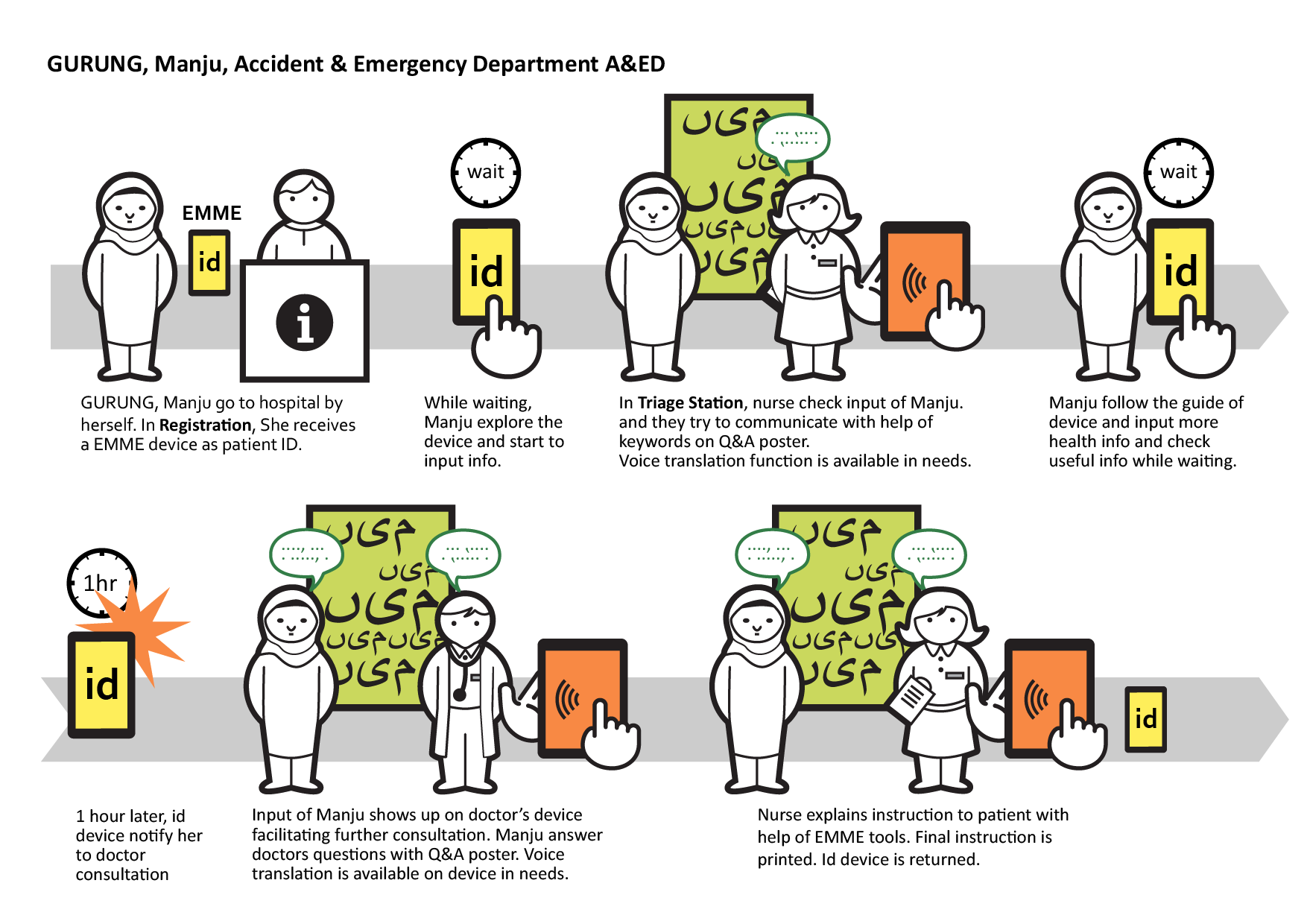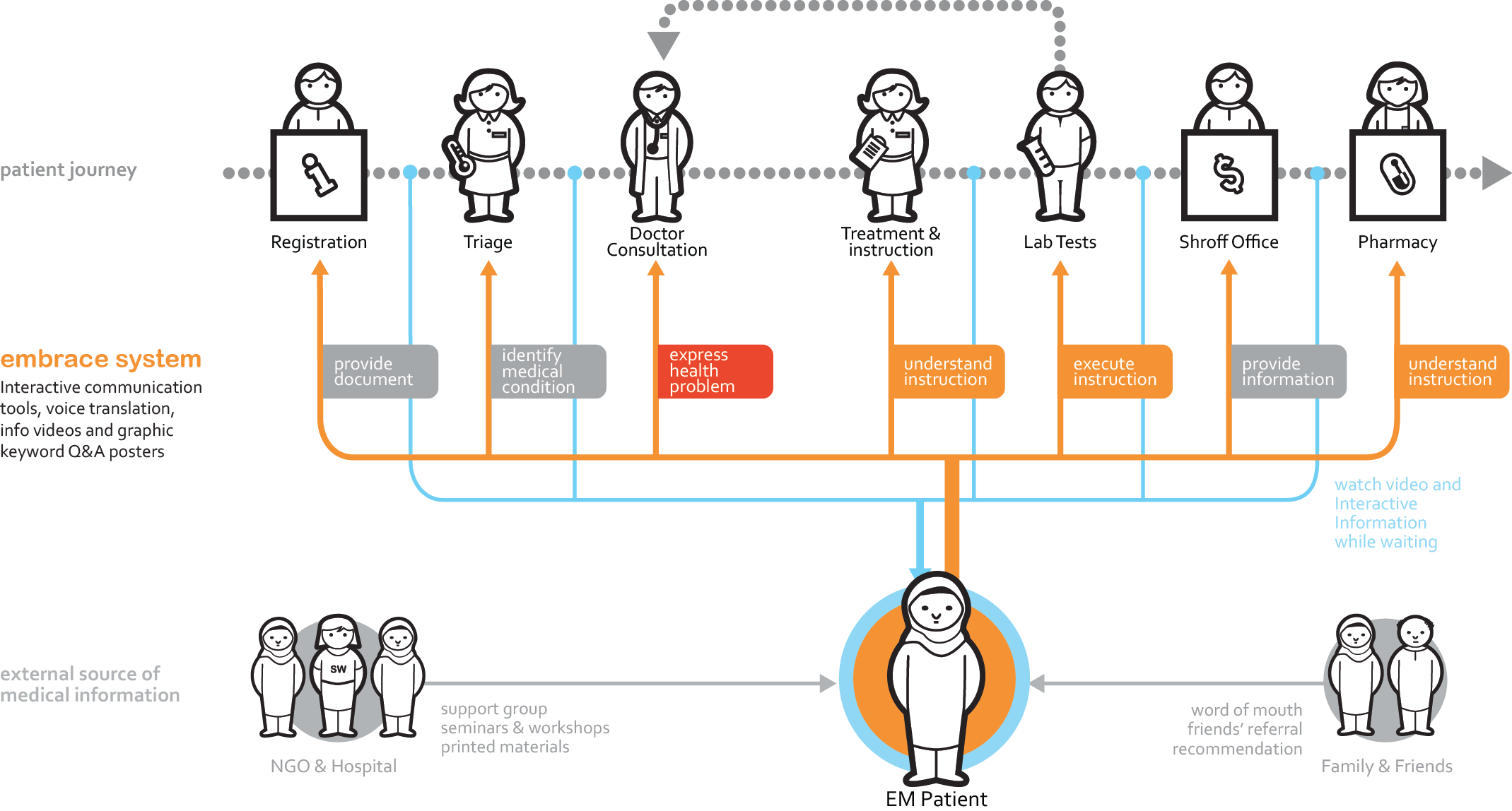This was a collaboration project initiated by Pok Oi Hospital under the New Territories West Cluster of Hospital Authority of Hong Kong. The project aimed to seek for opportunities of improving the service of hospital for ethnic minority groups through interaction design.
“Embrace – comforting Medical Experience for Ethnic Minority” developed from initial research and analysis stage, to idea generation and concept execution. By understanding the problems and difficulties faced by the target group, insights were identified and relevant solutions were suggested accordingly. It was expected that this project could serve as a proposal for further development and execution for the benefit of improving the medical care services for Ethnic Minority Group.
用户需求研究 User research – Quotes from Stakeholders
- “For effectiveness, activities with interaction will be better because there is direct response and effect on their understanding. Even a talk in Urdu may not sound related to them. But for activities, they can associate to their health issue and daily life.”
- Patient’s emotion: Nervous, frustration, stress, uneasy, no patient. Sometimes this is caused by not understanding the system. Sometimes it is a general sense of discrimination derived from other occasions.
- “Interpreters are in charge of the conversation. If they are family member, they answer to the questions of doctors without asking the patient! They may think that they know the patient’s condition well enough. It is doubted if they will translate all conversation to the patient.”
- “Doctor may assume that EM patient couldn’t understand and then cut off some of the relevant information.”
- “Communication can raise the tolerance of patient.”
- “Someone who can speak URDU should be employed in hospital to do occasion translation.”
- “In hospital , is always waiting and waiting. I have brought newspaper to kill time.”
- “EM ladies love TV drama and movies. If you can make video by Khalid Khan, your work will be very popular.”
- “How can service providers comfort the patient if they cannot voice out their needs and feelings?”
- “Without interpreter, they cannot explain themselves fully, and have phobia, and prefer not go to the hospital.”
描绘现状流程模型 Current Patient Journey

It is important to understand how patients proceed through the care delivery system. The best way to achieve this is through process mapping. Process maps are an effective way to identify constraints and bottlenecks, and unnecessary process steps. Process mapping is a useful diagnostic tool for determining where problems lie. Understanding the process from the patient perspective is essential if patient focussed service improvements are to be made.
Source of Medical Information – either from words of mouth of family and friends or for activities and seminars organized by NGOs. However EM patients may not get update information from local citizens, and they are not keen on reading printed materials.
Accompanies during visit to hospital – always accompanied by family members or friends who can speak English and/or Cantonese. They will act as interpreters for the EM ladies. They are very much relied on this indirect communication which sometime may be inaccurate and misunderstanding.
Professional Interpreters – If time allows such as patients of Special Out Patient Department, interpretation will be arranged in the expenses of the hospital. But this may not be available in A&ED.
导出现状问题 What are the problems?
There are two main problems in a typical patient journey. It is not uncommon for EM ladies to bring along with their little children to the hospital as their interpreters. However although the small children may be growing up and studying in local school, and they can speak English and even Cantonese, they are usually too small to understand medical conditions and not to mention those complicated medical terms. This may leads to inaccurate translation and severe danger.
Also medical instruction is always in Chinese and sometimes in English. There is no native language instruction materials. It is very rare to have information and instructions translated in Urdu or Hindi. It would be very difficult for EM patients to remember and review those important instructions and precautions.
Furthermore the adult family member to dominate the whole conversation with the doctor and nurse without asking feedbacks from the patient herself as if they knows everything about her health condition. The patient has no clue about what they are talking about her, and the frustration and confusion will accumulate.
Also there is a tendency for the doctors and nurses to talk solely to the interpreter instead of the patient. There is case that when the nurse knows one family member can speak Cantonese, she will talk fully in Cantonese about the medical instruction of a lab test disregard the fact that the language level is actually quite low.
01-Stress point

Different levels of communication are required during the patient journey, from quantitative to qualitative, from pronunciation of their names, to duration and dates, to expression of sickness and evaluation of pain. Stress and anxiety accumulate when the patients cannot express themselves, and could not comprehend the diagnosis about their own health, cannot read instructions, confuse about what practitioners are discussing.
Patient will also feel frustrated when they are not sure about what is going to happen in the next step of patient journey.
02-Wasted Time

In current patient journey, nearly 2/3 of the time spent in hospital is pure waiting. Patients have to wait for preliminary examination in triage station, and then wait for doctor consultation. If they need to do lab test before diagnosis, they have to queue up for lab test and wait the result. At last they need to wait for getting their medication. The waiting could last for a few hours, in extreme case a day. In between productive activities are nonproductive waiting hours. Patients has nothing to do for their health.
“How can we help them to overcome this communication barrier?”
“What if both patients and caregivers could easily express themselves and understand each other?“
“How can patients make better use of this wasted time? ”
“What if patients could express their concerns and acquire useful information while waiting?”
基于问题的优化洞见 Insights
1. Build confidence for EM patients and let them express.
“Without interpreter, they cannot explain themselves fully, have phobia, and prefer not go to the hospital.”
2. Let the patient take control of the journey.
“Doctor and nurse tend to talk to interpreters instead of to EM patient”
3. Prevent inaccurate translation.
“I don’t really understand those difficult medical terms. Sometimes I need to call my daddy to do further interpretation.”
4. Make use of the waiting time.
“In hospital , is always waiting, waiting. I have brought newspaper to kill time.”
5. To create consistent contact point for adherence.
“One patient to many people in various steps of the journey”
基于洞见的项目陈述 Project Statement
This project aims to provide Ethnic Minority patients with comforting Medical Experience. It empowers them with effective tools to communicate their own health condition without relying on interpreters.
embrace is an innovative communication system consists of digital devices, keyword Q&A aids and graphic posters that allow users to communicate their own health condition without relying on interpreters. The objectives are to overcome language barrier, build confidence for EM patients to express and take control of the journey, to communicate accurate medical information and instruction, to make use of the waiting time, and to create consistent contact point for adherence.
建构交互模型 Interaction Model
建构用户使用模型 Proposed Patient Journey

结论 Conclusion
The project solutions were designed based on thorough research and study of current patient journey, and how stakeholders interact with each other in the process. Patients’ difficulties and requirements were observed and analysis in this two months project. With the contribution of frontline medical care professional and management, opportunities are opened in terms of practicality in real hospital context. Also the inputs from social workers and programme coordinators from NGOs help understanding the characteristic and behaviour of the target group.
The project addressed two major opportunities enhancing the medical experience of Ethnic Minority group:
1. Help them to overcome the communication barrier
2. Patients make better use of the waiting time
The project focused on providing solutions for the above design opportunities. No fictional technology was employed. User capability was taken into consideration, and the solutions ranged from low-tech graphic posters to mid-tech digital input devices, no more complicated than an ordinary ATM machine. The key features took advantage of back-end translation and voice translation that helped seamless communication. Users did not have to worry about the technology but just enjoy the benefits from it.
I have confident that the proposed system can answer to the project statement:
”Providing Ethnic Minority patients with comforting Medical Experience. It empowers them with effective tools to communicate their own health condition without relying on interpreters.”


